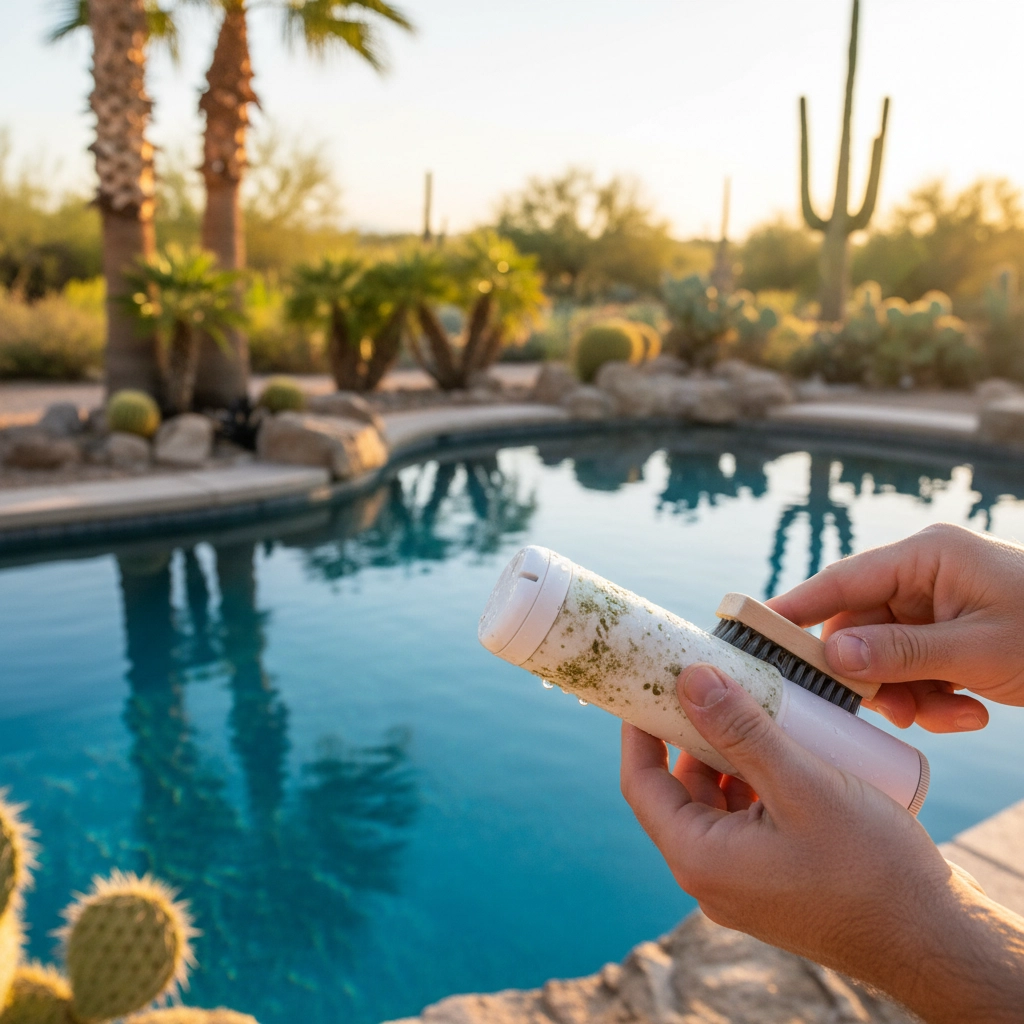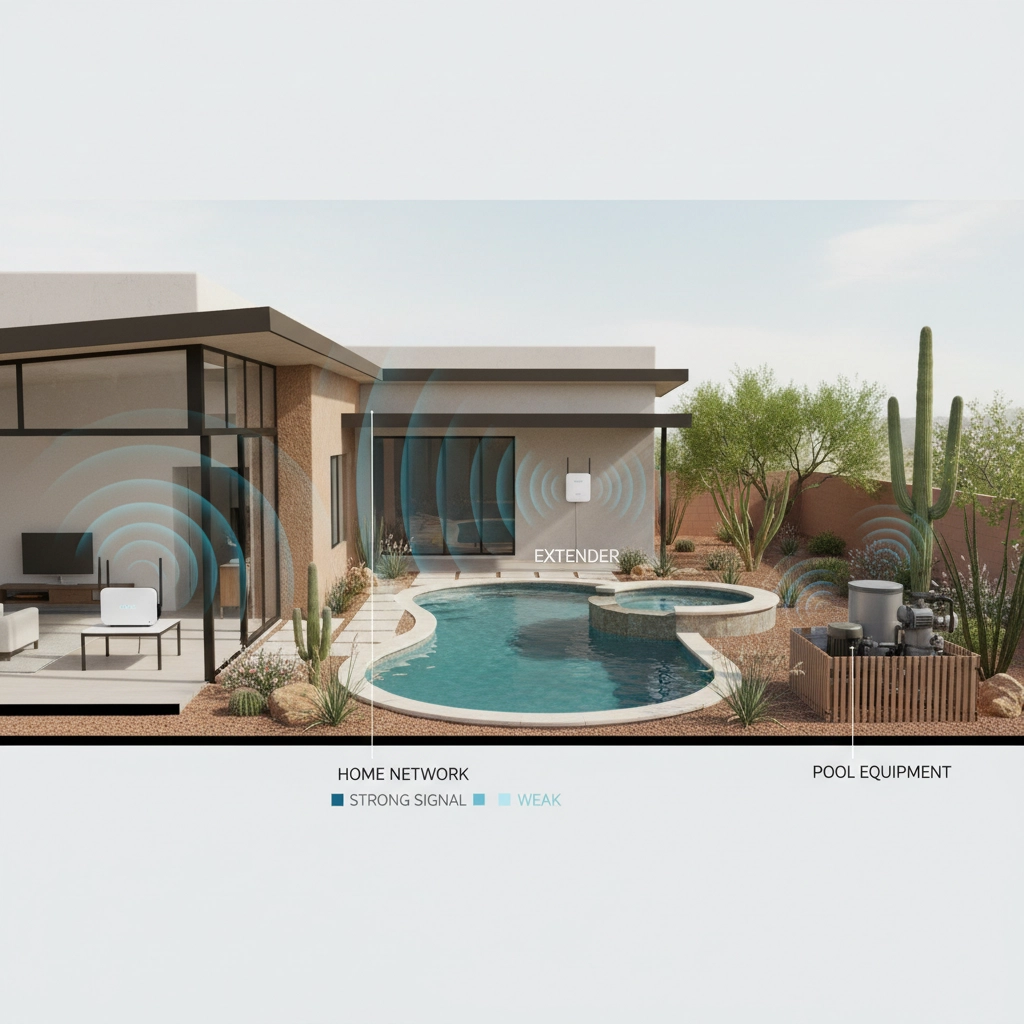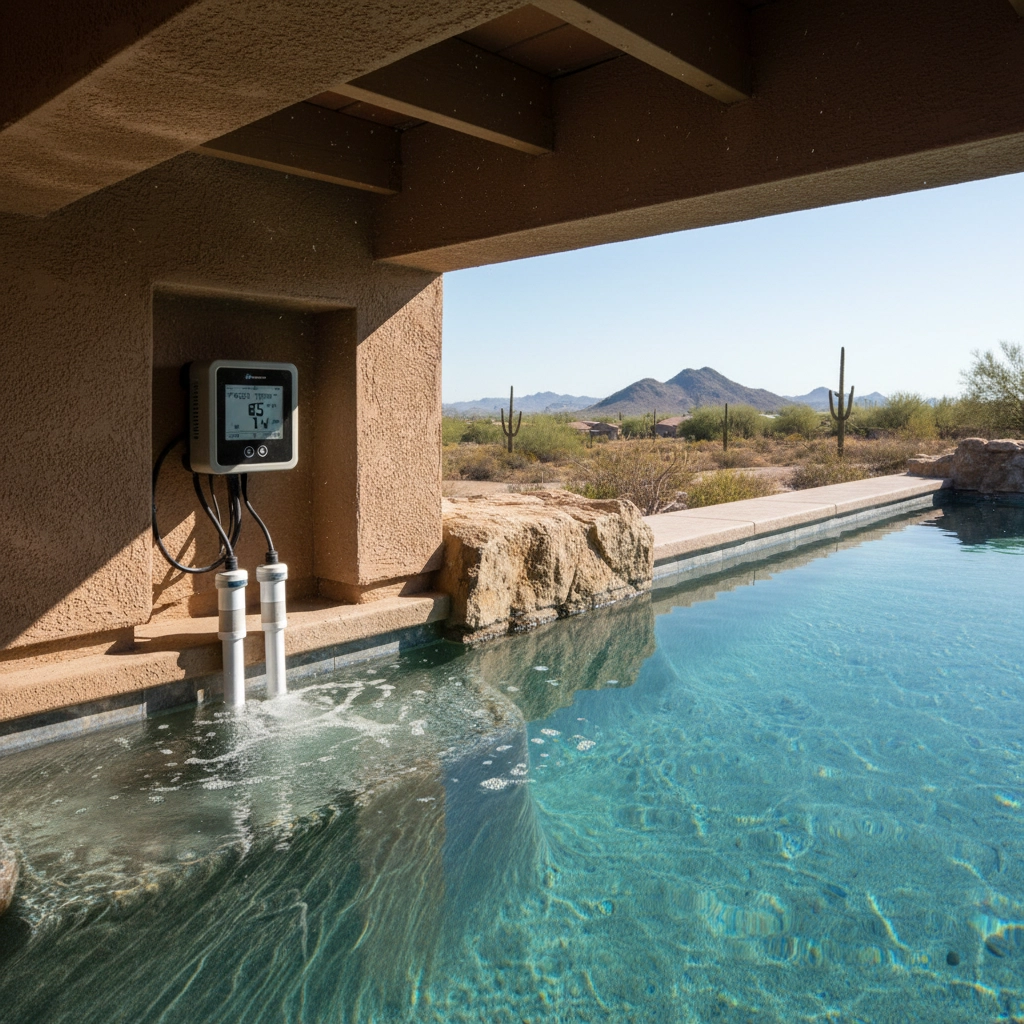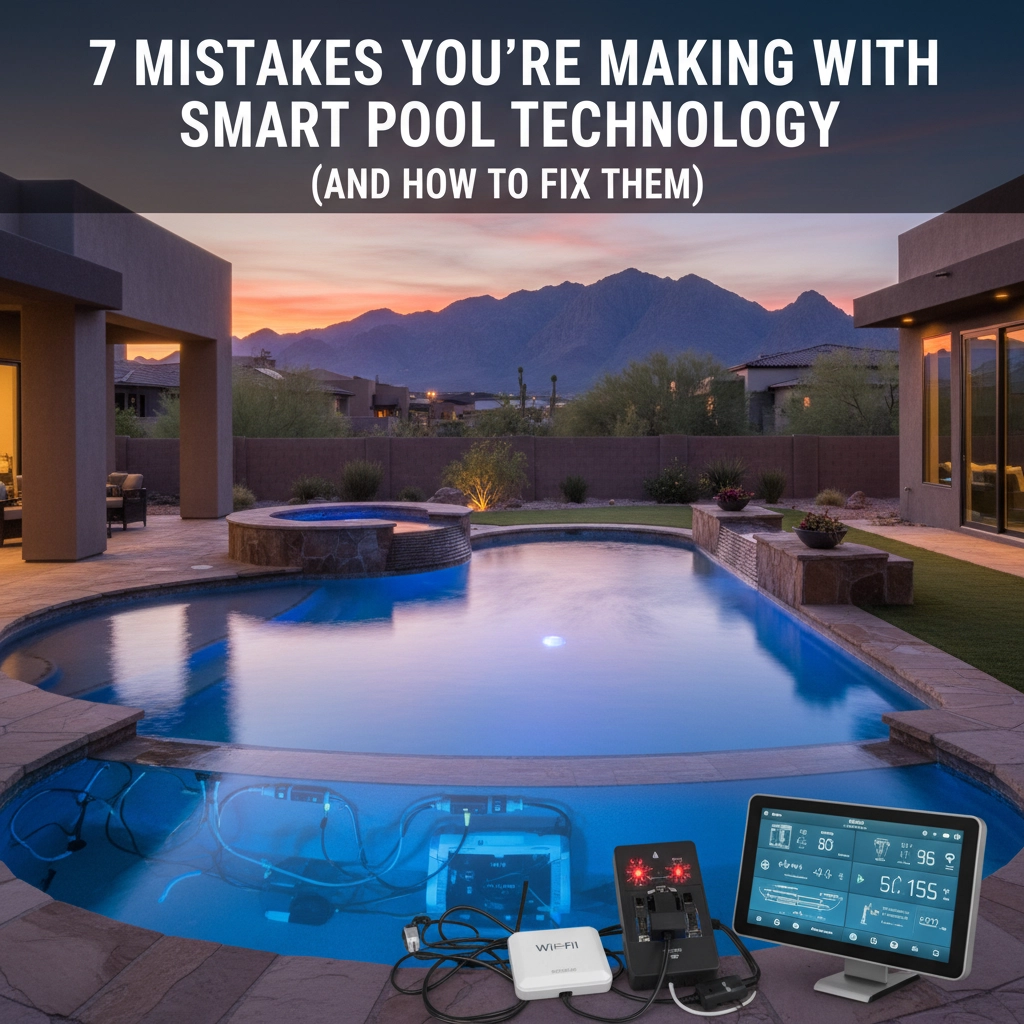Smart pool technology has revolutionized how homeowners in Queen Creek, San Tan Valley, Mesa, Gilbert, and Chandler manage their pools. From automated chemical dispensers to WiFi-enabled monitoring systems, these innovations promise crystal-clear water with minimal effort. However, many pool owners unknowingly sabotage their smart systems, leading to frustration, wasted money, and pool problems that could easily be avoided.
Let's dive into the seven most common smart pool technology mistakes and learn how to fix them once and for all.
1. Skipping Sensor Calibration and Maintenance
The Mistake: You installed your smart pool monitoring system and assumed it would work flawlessly forever. Many homeowners in Arizona's desert climate forget that sensors require monthly cleaning and calibration to deliver accurate readings.
Why It Happens: Pool monitoring sensors accumulate calcium buildup, algae, and mineral deposits from Arizona's hard water. Without regular maintenance, these sensors provide false readings, causing your automated systems to add incorrect amounts of chemicals.
The Fix: Clean your sensors monthly with a soft brush and manufacturer-approved cleaning solution. Calibrate them according to your device's instructions: usually every 30 days. Think of sensor maintenance like changing your car's oil: skip it, and you'll face expensive problems later.
Keep a maintenance log noting when you last cleaned and calibrated each sensor. Set phone reminders to make this routine automatic.

2. Poor WiFi Connectivity Planning
The Mistake: You placed your smart pool controller in the equipment area without considering WiFi signal strength. Many Gilbert and Chandler homeowners discover their pool equipment pad sits in a dead zone where WiFi barely reaches.
Why It Happens: Pool equipment is often located far from the house or blocked by concrete walls, metal equipment, and landscaping. Weak WiFi signals cause intermittent connections, preventing remote monitoring and control.
The Fix: Before installing smart pool equipment, test WiFi signal strength at your pool equipment location. Use your phone's WiFi analyzer or download a signal strength app. If the signal is weak, install a WiFi extender specifically rated for outdoor use.
For best results, position extenders halfway between your router and pool equipment. Weatherproof outdoor extenders work better than indoor models in Arizona's extreme temperatures.
3. Ignoring Software Updates
The Mistake: Your smart pool system has been working fine for months, so you ignore those update notifications on your phone app. Eventually, features stop working or the app becomes glitchy.
Why It Happens: Pool technology manufacturers regularly release updates that fix bugs, improve accuracy, and add new features. Outdated software can cause communication errors between your phone and pool equipment.
The Fix: Enable automatic updates for your pool management apps. Check monthly for firmware updates on your pool controllers and smart devices. Most systems allow updates through the mobile app: the process usually takes 10-15 minutes.
Create a quarterly maintenance routine: update software, check sensor calibration, and review automation schedules. This prevents small issues from becoming major headaches.
4. Incorrect Smart Device Placement
The Mistake: You mounted sensors and controllers wherever seemed convenient, without considering water circulation, sun exposure, or accessibility for maintenance.
Why It Happens: Installation seems straightforward, but proper placement significantly affects performance. Sensors placed in stagnant water areas or direct sunlight provide inaccurate readings.
The Fix: Install chemical sensors in areas with good water circulation but away from return jets, which can cause false readings from concentrated chemicals. Position them 12-18 inches below water surface for consistent readings.
Mount controllers in shaded areas protected from direct sunlight. Arizona's intense UV rays can damage electronics and LCD displays over time. Ensure easy access for maintenance: you'll thank yourself later when calibration time comes.

5. Setting Unrealistic Automation Schedules
The Mistake: You program your smart system to run everything simultaneously: filtration, heating, cleaning, and chemical dosing all at once. This overloads your electrical system and creates conflicting chemical readings.
Why It Happens: New smart pool owners often think more automation equals better results. However, pool systems work best when operations are properly sequenced and timed.
The Fix: Stagger automated functions throughout the day. Run filtration during off-peak electricity hours (typically 10 PM to 6 AM in Arizona). Schedule chemical dosing when the pool isn't being used: chemicals need circulation time to distribute evenly.
Set heater operation for early morning, giving water time to warm before afternoon swimming. Program automated cleaners to run when filtration pumps operate, maximizing debris removal efficiency.
For Mesa and Queen Creek pools, consider higher filtration during summer months when dust and debris increase. Adjust schedules seasonally rather than using year-round settings.
6. Neglecting Backup Systems and Manual Overrides
The Mistake: You rely completely on smart technology without understanding manual overrides or backup procedures. When technology fails, you're stuck waiting for repairs while your pool chemistry deteriorates.
Why It Happens: Smart systems make pool care seem effortless, leading owners to forget basic manual operations. However, electronics can fail, especially in Arizona's harsh environment.
The Fix: Learn manual operation procedures for all automated equipment. Keep a basic test kit for pH, chlorine, and alkalinity: technology should enhance manual testing, not replace it entirely.
Document manual override procedures and keep instructions accessible. Practice switching to manual mode quarterly, ensuring you're prepared when automation fails.
Maintain relationships with local pool professionals for emergency service. Companies familiar with Queen Creek and San Tan Valley can provide faster response times when smart systems malfunction.

7. Over-Chemical Dosing From Faulty Sensors
The Mistake: Your automated chemical dispenser keeps adding chlorine or pH adjusters based on incorrect sensor readings, creating an endless cycle of over-treatment that wastes money and potentially damages pool surfaces.
Why It Happens: Dirty or poorly calibrated sensors trigger unnecessary chemical additions. Arizona's mineral-rich water compounds this problem by coating sensors with calcium deposits that interfere with accurate readings.
The Fix: Cross-check automated readings with manual test strips weekly. If readings differ significantly, clean and recalibrate sensors immediately. Most discrepancies stem from sensor issues rather than actual water chemistry problems.
Set conservative dosing limits in your automation software. It's better to under-dose slightly and adjust manually than to over-dose and waste expensive chemicals. Program maximum daily chemical limits to prevent runaway dosing cycles.
Consider professional water analysis monthly during peak season. Local pool stores in Gilbert and Chandler can verify your smart system's accuracy using laboratory-grade equipment.
Protecting Your Investment
Smart pool technology represents a significant investment that can provide years of convenient, efficient pool management. However, like any sophisticated system, it requires proper setup, regular maintenance, and user understanding to perform optimally.
Remember that technology should simplify pool care, not complicate it. Start with basic automation features and gradually add complexity as you become comfortable with each system. Most importantly, maintain fundamental pool care knowledge: smart systems work best when operated by informed owners who understand pool chemistry and equipment basics.
By avoiding these seven common mistakes, your smart pool technology will provide the effortless pool management you expected when you made the investment. Your pool will stay cleaner, your chemical costs will decrease, and you'll spend more time enjoying your backyard oasis rather than troubleshooting equipment problems.
For complex smart pool system issues or professional installation advice, consider consulting with experienced pool service providers who understand both traditional pool care and modern automation systems. The right balance of technology and expertise ensures your Arizona pool stays perfect year-round.


0 Comments